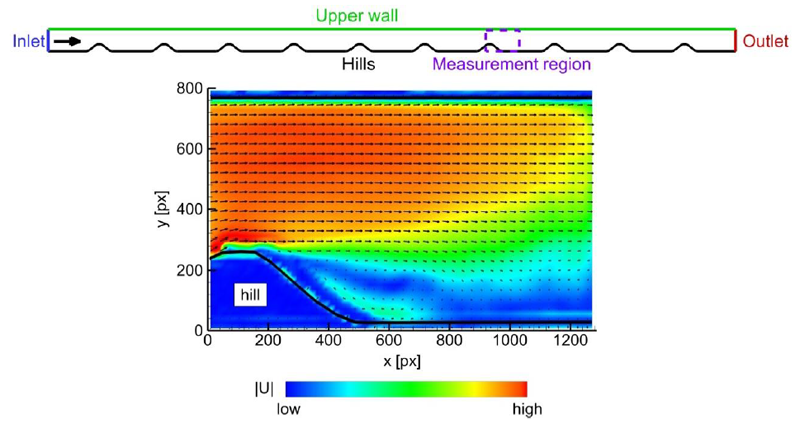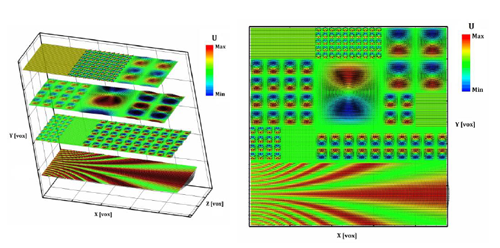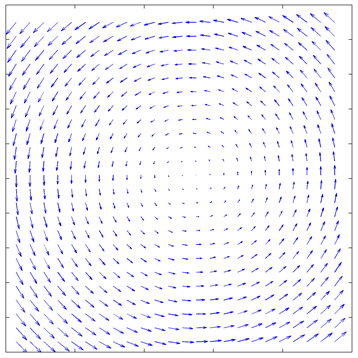
-
-
4th International PIV Challenge
Introduction
Since the 3rd PIV Challenege, held in 2005, substantial development efforts have resulted in significant improvements of PIV measurements in terms of, accuracy, resolution, dynamic range, and extention to higher dimensions, just to name a few. New processing methods, as well as measurement configurations have been developed, and superior hardware has become commercially available. Advanced imaging and velocity evaluation systems, such as Tomographic PIV, V3V, Astigmatism-PTV are rapidly spreading throughout the PIV community. Evaluation methods for time-resoved/high sampling rate image sequences such as multi-frame PIV, pyramid correlation, fluid trajectory correlation, and triple correlation are expected to further expand the dynamic range of PIV. Single-pixel ensemble correlation and other advanced PTV methods have demonstrated promising results that point to improvements in the spatial resolution of PIV. Advanced post-processing techniques of PIV data now allow calculating a wide range of flow quantities that traditionally have been mostly out of the reach of experimental fluid mechanics and were reserved primarily for numerical methods. These include but are not limited to the calculation of pressure fields, temperature fields, dissipation rate, vortex identification, Lagrangian coherent structures, etc. Finally, due to the great success of traditional PIV analysis, application of PIV to ever more complex imaging and flow situations are also rapidly increasing. X-ray PIV or Echo/Ultrasound PIV are some glaring examples.
In order to assess the current state of the art of PIV and to guide future development efforts, a 4th instance of the gInternational PIV Challengeh tradition is convened after 2001, 2003 and 2005. In the 4th PIV Challenge, 3D-PIV and 2D micro-PIV image sequences are considered, in order to explore challenges specific to 3D and micro domains. Additionally, a 2D time-resolved image sequence, which exhibits typical measurement challenges caused by the low intensity of high repetition rate lasers and large pixel size of high speed cameras, is provided. The participants are free to use any acceptable and documented velocity evaluation approach of their choice, such as correlation-based image analysis techniques, Particle Tracking Velocimetry (PTV) or optical flow based methods.
Test cases
Case A: µ-PIV

Case description
- A micro-channel flow that was driven by 200 bar pressure.
- Fluorescent polystyrene flow tracer particles with a diameter of 1 µm were added to the flow and captured with an inter-frame time of 120 ns using a sCMOS camera.
Challenges
- 600 double-frame images were recorded.
- Strong gradients and high dynamic velocity range.
- Depth of correlation and optical aberrations due to the thick window that is used to sustain the internal pressure.
- Low image signal-to-noise ratio as typical for µPIV applications.
Providers
Cierpka C & Kähler CJ
Download
Images (4.18GB)
Documents
Case B: Time resolved PIV

Case description
- Time resolved PIV recordings of the flow over a periodic hill.
- Measurements were performed in a water tunnel.
Challenges
- Large velocity dynamic range and out-of-plane motion effects are present.
- Small particle images caused by the large pixel size typical for high-speed cameras.
- Near wall effects.
Providers
Hain R & Kähler CJ
Download
Images (1.08GB)
Documents
Case C: Conventional 3D PIV synthetic images for the assessment of spatial resolution and accuracy.

Case description
- Synthetic images of a complex flow field, composed of a set of 3D vortices with different wavelengths and amplitudes and a periodic pseudo-jet.
- Projection images of 4 cameras are provided to the participants for several values of seeding particle concentration.
Challenges
- Optimization of the particle image density in terms of maximum spatial resolution with minimum loss of accuracy.
Providers
Discetti S & Astarita T
Download
Images (156MB)
Documents
Case D: 3D PIV synthetic images based on time resolved DNS turbulent flow

Case description
- A 3D PIV experiment is simulated imposing the velocity field of a Direct Numerical Simulation (DNS) of an isotropic incompressible turbulent flow.
- Projection images of 4 cameras are provided to the participants for several time resolved steps of the simulation, for a relatively high particle concentration.
Providers
Discetti S & Astarita T
Download
Images (992MB)
Documents are included in those of Case C
Case E: Vortex Ring Time Resolved, Stereo-PIV
Case description
- Time resolved stereoscopic PIV (2-Dimensional 3-component - 2D3C) of a piston generated axissymmetric laminar vortex ring.
- Measurements were performed in a water tank using 27 µm (mean diameter) flow tracers with 1kHz frame rate.
- Multiple camera views were recorded
Challenges
- Large velocity dynamic range and out-of-plane motion effects are present.
- Small particle images caused by the large pixel size typical for high-speed cameras.
- Illumination and image artifacts
- Non optimum stereoscopic imaging arrangent
Providers
La Foy RR & Vlachos PP
Download
Images (197MB)
Documents
Case F: Solid body rotation

Case description
- 2D-PIV of a liquid column rotating at steady uniform angular velocity.
- An acrylic cylinder was filled with water/glycerin solution containing silver coated hollow glass particle. The cylinder was then placed on the turntable of an audio record player that spins the cylinder at a constant speed of 33 1/3 rpm. After a few minutes the flow reached steady solid body rotation.
- Laser light sheet illuminated a horizontal cross section of the flow and particles were imaged by C-MOS camera.
Challenges
- Bias error estimated from discripancy between measured and expected displacements
- Rotation speed calcurated from circulation over a certain domain
- Human factor affected to the results
Providers
Sakakibara J
Download
Images (4.6MB)
Documents
Timeline
- November 23, 2013: Open registration.
- December 15, 2013: End of registration period.
- December 21, 2013: Distribution of test cases for Case A,B,C and D.
- February 6, 2013: Distribution of test cases for Case E.
- February 28, 2014: Submission of results for Case A and C.
- March 31, 2014: Submission of results for Case B and D.
- April 15, 2014: Submission of results for Case E.
- July 5, 2014: Presentation and discussion of the results. Onsite evaluation of Case F.
- December 9, 2015: Article submitted to Experiments in Fluids.
- May 23, 2016: Article published on-line
- May 24, 2016: Images became available to download for anyone
Workshop
The results was presented on July 5th, 2014 at
Hotel Real Palácio in Lisbon prior to the 17th International Symposium on Applications of Laser Techniques to Fluid Mechanics.
Scientific organization committee
‡ replace '***' to '@'
Advisory board
Stanislas M, Ecole Centrale de Lille, France
Okamoto K, University of Tokyo, Japan
Adrian RJ, Arizona State University, USA
|
Copyright 2013-2016 All Right Reserved. International PIV Challenge |
|

